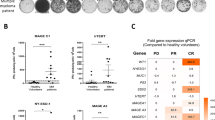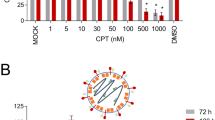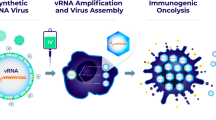Abstract
Because of their ability to replicate, the dose–response relationships of oncolytic viruses cannot easily be predicted. To better understand the pharmacokinetics of virotherapy in relation to viral dose and schedule, we administered MV-CEA intraperitoneally in an orthotopic mouse model of ovarian cancer. MV-CEA is an attenuated oncolytic measles virus engineered to express soluble human carcinoembryonic antigen (CEA), and the virus is currently undergoing phase I clinical testing in patients with ovarian cancer. Plasma CEA levels correlate with numbers of virus-infected tumor cells at a given time, and were used as a surrogate to monitor the profiles of viral gene expression over time. The antineoplastic activity of single- or multiple-dose MV-CEA was apparent over a wide range of virus doses (103–108 TCID50), with little reduction in observed antitumor efficacy, even at the lowest tested dose. However, analysis of CEA profiles of treated mice was highly informative, illustrating the variability in virus kinetics at different dose levels. The highest doses of virus were associated with higher initial levels of tumor cell killing, but the final outcome of MV-CEA therapy at all dose levels was a partial equilibrium between virus and tumor, resulting in significant slowing of tumor growth and enhanced survival of the mice.
This is a preview of subscription content, access via your institution
Access options
Subscribe to this journal
Receive 12 print issues and online access
$259.00 per year
only $21.58 per issue
Buy this article
- Purchase on Springer Link
- Instant access to full article PDF
Prices may be subject to local taxes which are calculated during checkout



Similar content being viewed by others
References
Partridge EE, Barnes MN . Epithelial ovarian cancer: prevention, diagnosis, and treatment. CA Cancer J Clin 1999; 49: 297–320.
Kirn D, Martuza RL, Zwiebel J . Replication-selective virotherapy for cancer: biological principles, risk management and future directions. Nat Med 2001; 7: 781–787.
Barnes MN, Coolidge CJ, Hemminki A, Alvarez RD, Curiel DT . Conditionally replicative adenoviruses for ovarian cancer therapy. Mol Cancer Ther 2002; 1: 435–439.
Vasey PA, Shulman LN, Campos S, Davis J, Gore M, Johnston S et al. Phase I trial of intraperitoneal injection of the E1B-55-kd-gene-deleted adenovirus ONYX-015 (dl1520) given on days 1 through 5 every 3 weeks in patients with recurrent/refractory epithelial ovarian cancer. J Clin Oncol 2002; 20: 1562–1569.
Nemunaitis J, Cunningham C, Buchanan A, Blackburn A, Edelman G, Maples P et al. Intravenous infusion of a replication-selective adenovirus (ONYX-015) in cancer patients: safety, feasibility and biological activity. Gene Therapy 2001; 8: 746–759.
Ahlert T, Sauerbrei W, Bastert G, Ruhland S, Bartik B, Simiantonaki N et al. Tumor-cell number and viability as quality and efficacy parameters of autologous virus-modified cancer vaccines in patients with breast or ovarian cancer. J Clin Oncol 1997; 15: 1354–1366.
Heise C, Ganly I, Kim YT, Sampson-Johannes A, Brown R, Kirn D . Efficacy of a replication-selective adenovirus against ovarian carcinomatosis is dependent on tumor burden, viral replication and p53 status. Gene Therapy 2000; 7: 1925–1929.
Hirasawa K, Nishikawa SG, Norman KL, Alain T, Kossakowska A, Lee PW . Oncolytic reovirus against ovarian and colon cancer. Cancer Res 2002; 62: 1696–1701.
Nakamori M, Fu X, Meng F, Jin A, Tao L, Bast Jr RC et al. Effective therapy of metastatic ovarian cancer with an oncolytic herpes simplex virus incorporating two membrane fusion mechanisms. Clin Cancer Res 2003; 9: 2727–2733.
Unno Y, Shino Y, Kondo F, Igarashi N, Wang G, Shimura R et al. Oncolytic viral therapy for cervical and ovarian cancer cells by Sindbis virus AR339 strain. Clin Cancer Res 2005; 11: 4553–4560.
Shafren DR, Sylvester D, Johansson ES, Campbell IG, Barry RD . Oncolysis of human ovarian cancers by echovirus type 1. Int J Cancer 2005; 115: 320–328.
Kanerva A, Zinn KR, Peng KW, Ranki T, Kangasniemi L, Chaudhuri TR et al. Noninvasive dual modality in vivo monitoring of the persistence and potency of a tumor targeted conditionally replicating adenovirus. Gene Therapy 2005; 12: 87–94.
Myers R, Greiner S, Harvey M, Soeffker D, Frenzke M, Abraham K et al. Oncolytic activities of approved mumps and measles vaccines for therapy of ovarian cancer. Cancer Gene Ther 2005; 12: 593–599.
Peng KW, TenEyck CJ, Galanis E, Kalli KR, Hartmann LC, Russell SJ . Intraperitoneal therapy of ovarian cancer using an engineered measles virus. Cancer Res 2002; 62: 4656–4662.
Dorig RE, Marcil A, Chopra A, Richardson CD . The human CD46 molecule is a receptor for measles virus (Edmonston strain). Cell 1993; 75: 295–305.
Riley-Vargas RC, Gill DB, Kemper C, Liszewski MK, Atkinson JP . CD46: expanding beyond complement regulation. Trends Immunol 2004; 25: 496–503.
Bjorge L, Hakulinen J, Wahlstrom T, Matre R, Meri S . Complement-regulatory proteins in ovarian malignancies. Int J Cancer 1997; 70: 14–25.
Fishelson Z, Donin N, Zell S, Schultz S, Kirschfink M . Obstacles to cancer immunotherapy: expression of membrane complement regulatory proteins (mCRPs) in tumors. Mol Immunol 2003; 40: 109–123.
Peng KW, Facteau S, Wegman T, O'Kane D, Russell SJ . Non-invasive in vivo monitoring of trackable viruses expressing soluble marker peptides. Nat Med 2002; 8: 527–531.
Panza N, Pacilio G, Campanella L, Peluso G, Battista C, Amoriello A et al. Cancer antigen 125, tissue polypeptide antigen, carcinoembryonic antigen, and beta-chain human chorionic gonadotropin as serum markers of epithelial ovarian carcinoma. Cancer 1988; 61: 76–83.
Meier W, Baumgartner L, Stieber P, Hasholzner U, Fateh-Moghadam A . Significance of tumor marker determinations in the primary therapy of ovarian cancer. Anticancer Res 1997; 17: 2949–2951.
Katayama Y, Hirano A, Wong TC . Human receptor for measles virus (CD46) enhances nitric oxide production and restricts virus replication in mouse macrophages by modulating production of alpha/beta interferon. J Virol 2000; 74: 1252–1257.
Mrkic B, Pavlovic J, Rulicke T, Volpe P, Buchholz CJ, Hourcade D et al. Measles virus spread and pathogenesis in genetically modified mice. J Virol 1998; 72: 7420–7427.
Wodarz D . Viruses as antitumor weapons: defining conditions for tumor remission. Cancer Res 2001; 61: 3501–3507.
Wodarz D . Gene therapy for killing p53-negative cancer cells: use of replicating versus nonreplicating agents. Hum Gene Ther 2003; 14: 153–159.
Acknowledgements
We thank Maureen Craft for excellent secretarial support and the Molecular Medicine Program Viral Vector Production Laboratory (Guy Griesmann, Kirsten Langfield, Julie Sauer, Sharon Stephan, Henry Walker and Troy Wegman) for supply of the MV-CEA virus. This work was supported by the Olivier S and Jennie O Donaldson Charitable Trust, George M Eisenberg Foundation for Charities and NIH Grants CA100634, CA15083 and HL66958.
Author information
Authors and Affiliations
Corresponding author
Rights and permissions
About this article
Cite this article
Peng, KW., Hadac, E., Anderson, B. et al. Pharmacokinetics of oncolytic measles virotherapy: eventual equilibrium between virus and tumor in an ovarian cancer xenograft model. Cancer Gene Ther 13, 732–738 (2006). https://doi.org/10.1038/sj.cgt.7700948
Received:
Revised:
Accepted:
Published:
Issue Date:
DOI: https://doi.org/10.1038/sj.cgt.7700948
Keywords
This article is cited by
-
Optimizing oncolytic virotherapy in cancer treatment
Nature Reviews Drug Discovery (2019)
-
Oncolysis by paramyxoviruses: preclinical and clinical studies
Molecular Therapy - Oncolytics (2015)
-
Targeting gallbladder cancer: oncolytic virotherapy with myxoma virus is enhanced by rapamycin in vitro and further improved by hyaluronan in vivo
Molecular Cancer (2014)
-
Dynamics of melanoma tumor therapy with vesicular stomatitis virus: explaining the variability in outcomes using mathematical modeling
Gene Therapy (2012)
-
Therapeutic Potential of Oncolytic Measles Virus: Promises and Challenges
Clinical Pharmacology & Therapeutics (2010)



